Hydrogen Dispersion and Ventilation Effects in Enclosures under Different Release Conditions
Abstract
:1. Introduction
2. Materials and Methods
2.1. Hydrogen Dispersion Experiment
2.2. CFD Modeling of the Hydrogen Dispersion
3. Results
3.1. Hydrogen Dispersion Analyses
3.2. The Hazard Mitigation by a Ventilation System
4. Discussion
| Test No. | Hydrogen Release Method | U [m/s] | D [m] | Fr |
|---|---|---|---|---|
| Test 1 | Single nozzle release | 129.78 | 4.00 × 10−3 | 4.29 × 105 |
| Test 2 | Multi-point release | 2.75 | 2.75 × 10−2 | 2.80 × 101 |
5. Conclusions
Funding
Institutional Review Board Statement
Informed Consent Statement
Acknowledgments
Conflicts of Interest
References
- Kaplan, R.; Kopacz, M. Economic Conditions for Developing Hydrogen Production Based on Coal Gasification with Carbon Capture and Storage in Poland. Energies 2020, 13, 5074. [Google Scholar] [CrossRef]
- Lanz, A.; Heffel, J.; Messer, C. Hydrogen Fuel Cell Engines and Related Technologies—Module 3: Hydrogen Use in Internal Combustion Engines; College of the Desert: Palm Desert, CA, USA, 2001. [Google Scholar]
- Arunkumar, J. An Assessment on Polymer Electrolyte Membrane Fuel Cell Stack Components, Applied Physical Chemistry with Multidisciplinary Approache; Apple Academic Press Inc.: Mistwell Crescent, ON, Canada, 2018. [Google Scholar]
- Pethaiah, S.S.; Sadasivuni, K.K.; Jayakumar, A.; Ponnamma, D.; Tiwary, C.S.; Sasikumar, G. Methanol Electrolysis for Hydrogen Production Using Polymer Electrolyte Membrane: A Mini-Review. Energies 2020, 13, 5879. [Google Scholar] [CrossRef]
- Molnarne, M.; Schroeder, V. Hazardous properties of hydrogen and hydrogen containing fuel gases. Process. Saf. Environ. Prot. 2019, 130, 1–5. [Google Scholar] [CrossRef]
- Molkov, V. Fundamentals of Hydrogen Safety Engineering I; Vladimir Molkov & bookboon.com: London, UK, 2012; Volume 1. [Google Scholar]
- Tao, Y.; Qiu, J.; Lai, S.; Zhang, X.; Wang, G.; Ev, P. Collaborative Planning for Electricity Distribution Network and Transportation System Considering Hydrogen Fuel Cell Vehicles. IEEE Trans. Transp. Electrif. 2020, 6, 1211–1225. [Google Scholar] [CrossRef]
- European Commission. Directive 2014/94/EU—Deployment of Alternative Fuels Infrastructure; European Commission: Brussels, Belgium, 2014; Volume L307, p. 20. [Google Scholar]
- Lanz, A.; Heffel, J.; Messer, C. Hydrogen Fuel Cell Engines and Related Technologies—Module 1: Hydrogen Properties; College of the Desert: Palm Desert, CA, USA, 2001. [Google Scholar]
- International Organization for Standardization. ISO/TR 15916:2015 Basic Considerations for the Safety of Hydrogen Systems; PD ISO/TR 15916:2015; International Organization for Standardization: London, UK, 2015. [Google Scholar]
- Alcock, J.; Shirvill, L.; Cracknell, R. Compilation of Existing Safety Data on Hydrogen and Comparative Fuels. Eur. Integr. Hydrog. Proj. EIHP2 2001. Available online: http://www.eihp.org/public/documents/CompilationExistingSafetyData_on_H2_and_ComparativeFuels_S.pdf (accessed on 9 May 2021).
- Klassen, M. Modern Vehicle Hazards in Parking Structures and Vehicle Carriers. 2020. Available online: https://www.nfpa.org/News-and-Research/Data-research-and-tools/Building-and-Life-Safety/Modern-Vehicle-Hazards-in-Parking-Garages-Vehicle-Carriers (accessed on 9 May 2021).
- Brzezińska, D. Ventilation system influence on hydrogen explosion hazards in industrial lead-acid battery rooms. Energies 2018, 11, 2086. [Google Scholar] [CrossRef] [Green Version]
- Venetsanos, A.G.; Papanikolaou, E.; Delichatsios, M.; Garcia, J.; Hansen, O.R.; Heitsch, M.; Huser, A.; Jahn, W.; Jordan, T.; Lacome, J.-M.; et al. An inter-comparison exercise on the capabilities of CFD models to predict the short and long term distribution and mixing of hydrogen in a garage. Int. J. Hydrogen Energy 2009, 34, 5912–5923. [Google Scholar] [CrossRef]
- Bédard-Tremblay, L.; Fang, L.; Bauwens, L.; Cheng, Z.; Tchouvelev, A.V. Numerical simulation of hydrogen-air detonation for damage assessment in realistic accident scenarios. J. Loss Prev. Process Ind. 2008, 21, 154–161. [Google Scholar] [CrossRef]
- Jäkel, C.; Kelm, S.; Reinecke, E.A.; Verfondern, K.; Allelein, H.J. Validationstrategyfor CFD models describing safety-relevant scenarios including LH2/GH2 release and the use of passive auto-catalytic recombiners. Int. J. Hydrogen Energy 2014, 39, 20371–20377. [Google Scholar] [CrossRef]
- Melideo, D.; Baraldi, D. CFD analysis of fast filling strategies for hydrogen tanks and their effects on key-parameters. Int. J. Hydrogen Energy 2015, 40, 735–745. [Google Scholar] [CrossRef]
- Hoyes, J.R.; Ivings, M.J. CFD modelling of hydrogen stratification in enclosures: Model validation and application to PAR performance. Nucl. Eng. Des. 2016, 310, 142–153. [Google Scholar] [CrossRef] [Green Version]
- Giannissi, S.G.; Venetsanos, A.G. A comparative CFD assessment study of cryogenic hydrogen and LNG dispersion. Int. J. Hydrogen Energy 2019, 44, 9018–9030. [Google Scholar] [CrossRef]
- Tolias, I.C.; Giannissi, S.G.; Venetsanos, A.G.; Keenan, J.; Shentsov, V.; Makarov, D.; Coldrick, S.; Kotchourko, A.; Ren, K.; Jedicke, O.; et al. Best practice guidelines in numerical simulations and CFD benchmarking for hydrogen safety applications. Int. J. Hydrogen Energy 2019, 44, 9050–9062. [Google Scholar] [CrossRef]
- Terziev, A.; Antonov, I.; Velichkova, R. Appropriate CFD Turbulence Model for Improving Indoor Air Quality of Ventilated Spaces. Math. Modell. Civil Eng. 2014, 10, 1–8. [Google Scholar]
- Brennan, S.; Molkov, V. Safety assessment of unignited hydrogen discharge from onboard storage in garages with low levels of natural ventilation. Int. J. Hydrogen Energy 2013, 38, 8159–8166. [Google Scholar] [CrossRef]
- Lach, A.W.; Gaathaug, A.V.; Vaagsaether, K. Pressure peaking phenomena: Unignited hydrogen releases in confined spaces – Large-scale experiments. Int. J. Hydrogen Energy 2020, 45, 32702–32712. [Google Scholar] [CrossRef]
- Weiner, S.C. Advancing the hydrogen safety knowledge base. Int. J. Hydrogen Energy 2014, 39, 20357–20361. [Google Scholar] [CrossRef] [Green Version]
- Molkov, V.; Dobashi, R.; Suzuki, M.; Hirano, T. Venting of deflagrations: Hydrocarbon-air and hydrogen-air systems. J. Loss Prev. Process Ind. 2000, 13, 397–409. [Google Scholar] [CrossRef]
- Moradi, R.; Groth, K.M. Hydrogen storage and delivery: Review of the state of the art technologies and risk and reliability analysis. Int. J. Hydrogen Energy 2019, 44, 12254–12269. [Google Scholar] [CrossRef]
- Brzezinska, D.; Markowski, A.S. Experimental investigation and CFD modelling of the internal car park environment in case of accidental LPG release. Process Saf. Environ. Prot. 2017, 110, 5–14. [Google Scholar] [CrossRef]
- Brzezińska, D.; Dziubiński, M.; Markowski, A.S. Analyses of LPG Dispersion during Its Accidental Release in Enclosed Car Parks. Ecol. Chem. Eng. S 2017, 24, 249–261. [Google Scholar] [CrossRef] [Green Version]
- Brzezińska, D. LPG cars in a car park environment—How to make it safe. Int. J. Environ. Res. Public Health 2019, 16, 1062. [Google Scholar] [CrossRef] [PubMed] [Green Version]
- Brzezinska, D.; Markowski, A.S. Experimental evaluation of LPG release and dispersion in the enclosed car parks. Chem. Eng. Trans. 2016, 48, 253–258. [Google Scholar]
- He, J.; Kokgil, E.; Wang, L.; Ng, H.D. Assessment of similarity relations using helium for prediction of hydrogen dispersion and safety in an enclosure. Int. J. Hydrogen Energy 2016, 41, 15388–15398. [Google Scholar] [CrossRef] [Green Version]
- Molkov, V. Fundamentals of Hydrogen Safety Engineering II; Vladimir Molkov & bookboon.com: London, UK, 2012. [Google Scholar]
- Li, Y.; Xiao, J.; Zhang, H.; Breitung, W.; Travis, J.; Kuznetsov, M.; Jordan, T. Numerical analysis of hydrogen release, dispersion and combustion in a tunnel with fuel cell vehicles using all-speed CFD code GASFLOW-MPI. Int. J. Hydrogen Energy 2021, 46, 12474–12486. [Google Scholar] [CrossRef]
- Gong, L.; Duan, Q.; Sun, J.; Molkov, V. Similitude analysis and critical conditions for spontaneous ignition of hydrogen release into the atmosphere through a tube. Fuel 2019, 245, 413–419. [Google Scholar] [CrossRef]
- McGrattan, K.; Hostikka, S.; McDermott, R.; Floyd, J.; Weinschenk, C.; Overholt, K. Fire Dynamics Simulator Technical Reference Guide Volume 1: Mathematical Model (Sixth Edition). NIST Spec. Publ. 2015, 1, 1018. [Google Scholar]
- McGrattan, K.; Hostikka, S.; McDermott, R.; Floyd, J.; Vanella, M. Fire Dynamics Simulator User’s Guide. NIST Spec. Publ. 2019, 1019, 347. [Google Scholar]
- NIST. Hydrogen Density at different temperatures and pressures. In NIST Reference Fluid Thermodynamic and Transport Properties Database (REFPROP): Version 8.0; Gaithersburg, MD, USA, 2020; Available online: https://h2tools.org/hyarc/hydrogen-data/hydrogen-density-different-temperatures-and-pressures (accessed on 4 June 2021).
- FCH2Edu—European Educational Platform for Fuel Cells and Hydrogen. Available online: https://fch2edu.eu/ (accessed on 4 June 2021).
- Krishnapisharody, K.; Irons, G.A. A critical review of the modified Froude number in Ladle Metallurgy. Metall. Mater. Trans. B Process Metall. Mater. Process. Sci. 2013, 44, 1486–1498. [Google Scholar] [CrossRef]
- Brzezinska, D.; Sompolinski, M. The accuracy of mapping the airstream of jet fan ventilators by fire dynamics simulator. Sci. Technol. Built Environ. 2017, 23, 736–747. [Google Scholar] [CrossRef]

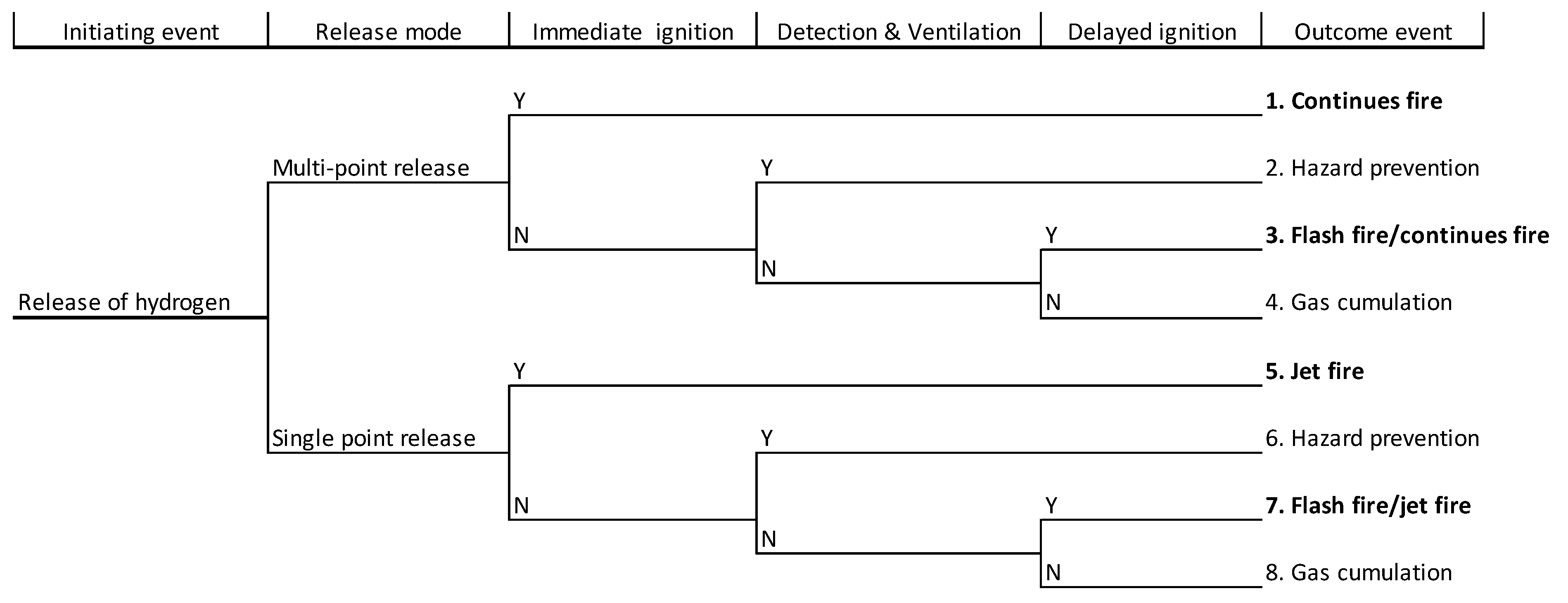
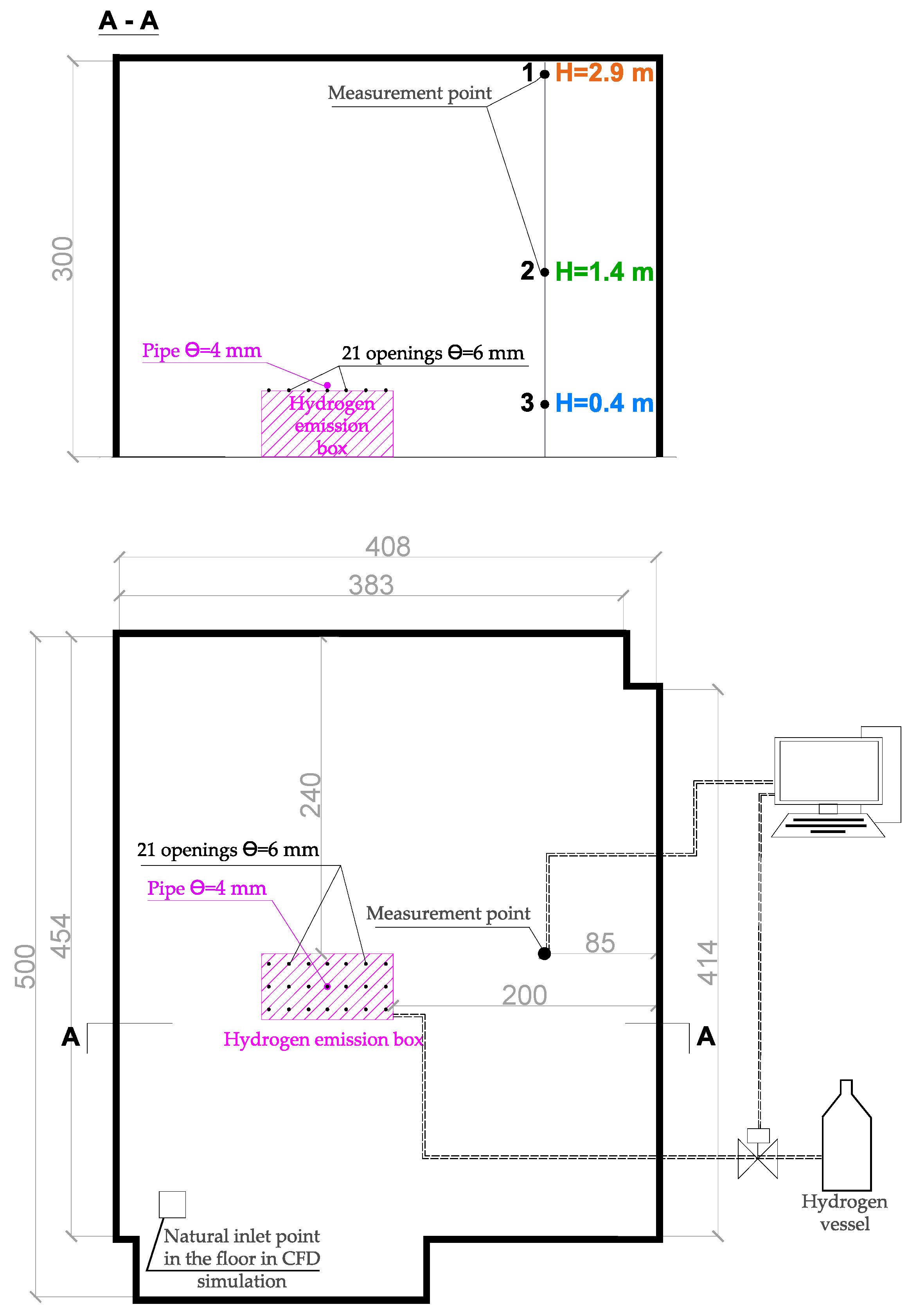

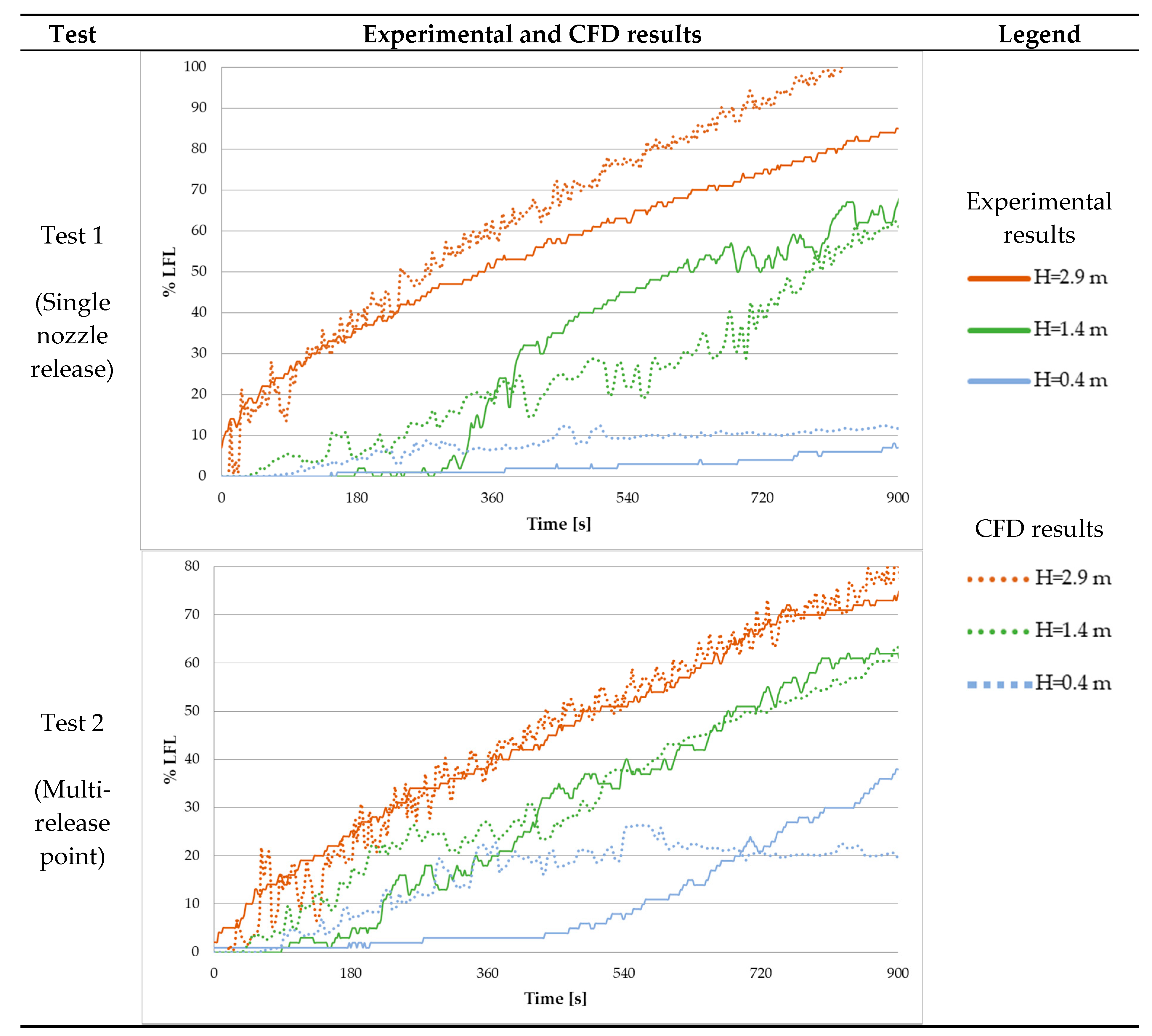

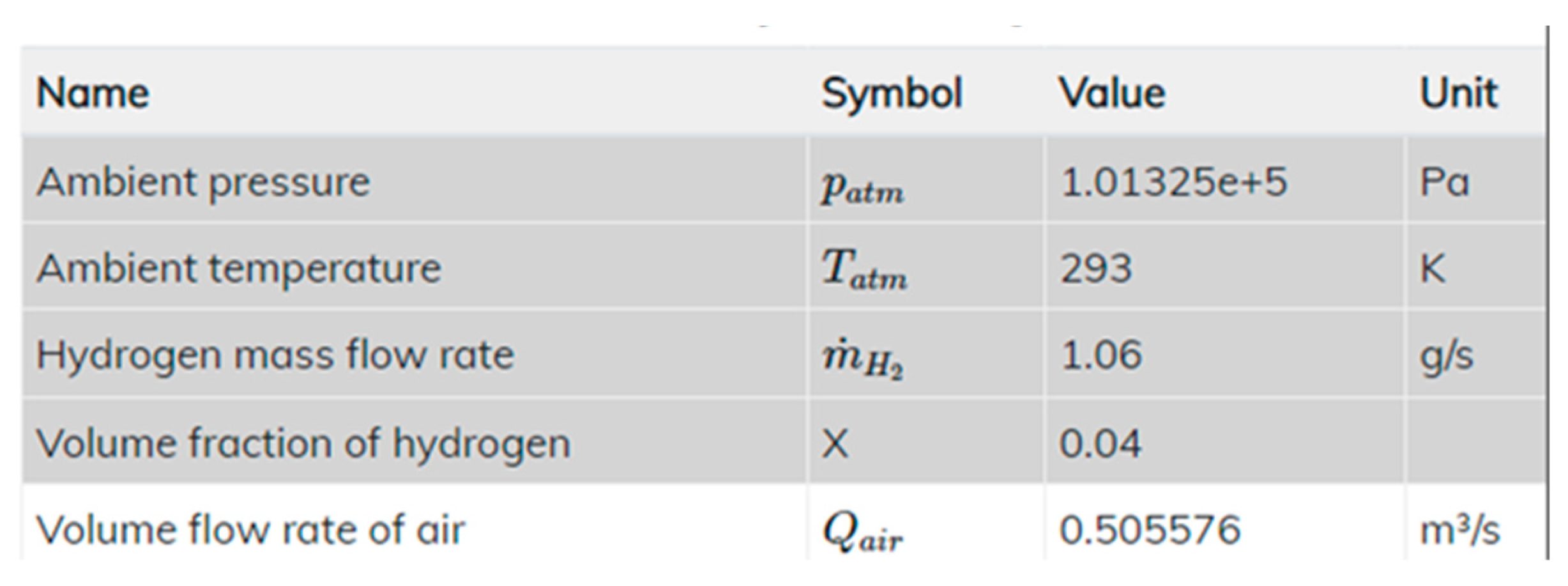
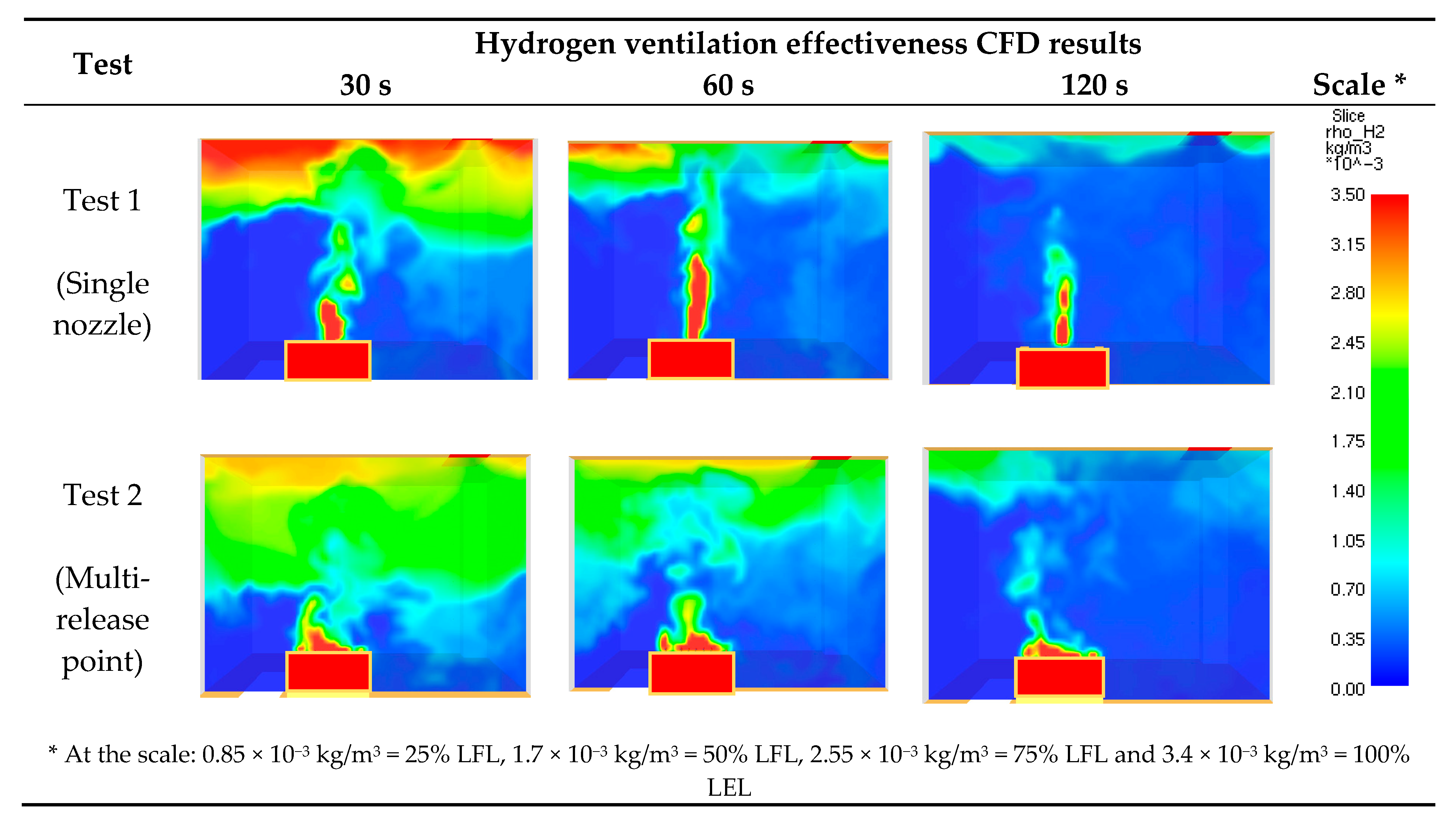
| Test No. | Hydrogen Release Method | Hydrogen Release Outflow [m3/s] | Hydrogen Density [kg/m3] | Hydrogen Mass Flow Rate [kg/s] | Hydrogen Release Source [m2] | Hydrogen Release Velocity [m/s] |
|---|---|---|---|---|---|---|
| Test 1 | Single nozzle release | 1.63 × 10−3 | 0.82 | 133 × 10−4 | 1.256 × 10−5 | 129.78 |
| Test 2 | Multi-point release | 1.63 × 10−3 | 0.82 | 1.33 × 10−4 | 5.935 × 10−4 | 2.75 |
Publisher’s Note: MDPI stays neutral with regard to jurisdictional claims in published maps and institutional affiliations. |
© 2021 by the author. Licensee MDPI, Basel, Switzerland. This article is an open access article distributed under the terms and conditions of the Creative Commons Attribution (CC BY) license (https://creativecommons.org/licenses/by/4.0/).
Share and Cite
Brzezińska, D. Hydrogen Dispersion and Ventilation Effects in Enclosures under Different Release Conditions. Energies 2021, 14, 4029. https://doi.org/10.3390/en14134029
Brzezińska D. Hydrogen Dispersion and Ventilation Effects in Enclosures under Different Release Conditions. Energies. 2021; 14(13):4029. https://doi.org/10.3390/en14134029
Chicago/Turabian StyleBrzezińska, Dorota. 2021. "Hydrogen Dispersion and Ventilation Effects in Enclosures under Different Release Conditions" Energies 14, no. 13: 4029. https://doi.org/10.3390/en14134029
APA StyleBrzezińska, D. (2021). Hydrogen Dispersion and Ventilation Effects in Enclosures under Different Release Conditions. Energies, 14(13), 4029. https://doi.org/10.3390/en14134029






